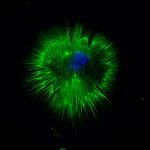Link to Pubmed [PMID] – 28854362
Link to DOI – S2211-1247(17)31106-310.1016/j.celrep.2017.08.014
Cell Rep 2017 Aug; 20(9): 2116-2130
Apela (also known as Elabela, Ende, and Toddler) is a small signaling peptide that activates the G-protein-coupled receptor Aplnr to stimulate cell migration during zebrafish gastrulation. Here, using CRISPR/Cas9 to generate a null, reporter-expressing allele, we study the role of Apela in the developing mouse embryo. We found that loss of Apela results in low-penetrance cardiovascular defects that manifest after the onset of circulation. Three-dimensional micro-computed tomography revealed a higher penetrance of vascular remodeling defects, from which some mutants recover, and identified extraembryonic anomalies as the earliest morphological distinction in Apela mutant embryos. Transcriptomics at late gastrulation identified aberrant upregulation of erythroid and myeloid markers in mutant embryos prior to the appearance of physical malformations. Double-mutant analyses showed that loss of Apela signaling impacts early Aplnr-expressing mesodermal populations independently of the alternative ligand Apelin, leading to lethal cardiac defects in some Apela null embryos.

